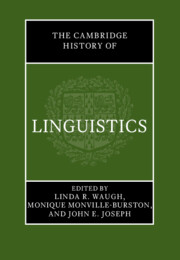Book contents
- The Cambridge History of Linguistics
- The Cambridge History of Linguistics
- Copyright page
- Dedication
- Contents
- Figures
- Tables
- Contributors
- Preface
- Acknowledgments
- Abbreviations, Acronyms, Special Symbols, and Other Conventions
- Introduction
- Part I Ancient, Classical, and Medieval Periods
- Part II Renaissance to Late Nineteenth Century
- Part III Late Nineteenth-through Twentieth-Century Linguistics
- Part IIIA Late Nineteenth Century through the 1950s: Synchrony, Autonomy, and Structuralism
- Part IIIB 1960–2000: Formalism, Cognitivism, Language Use and Function, Interdisciplinarity
- 17 Chomsky and the Turn to Syntax, Including Alternative Approaches to Syntax
- 18 Functionalist Dimensions of Grammatical and Discourse Analysis
- 19 Semantics and Pragmatics
- 20 Language and Philosophy, from Frege to the Present
- 21 Lexicology and Lexicography
- 22 Generative Phonology: its Origins, its Principles, and its Successors
- 23 Phonetics and Experimental Phonology, c. 1950–2000
- 24 Historical and Universal-Typological Linguistics
- 25 Language and Society
- 26 Language and Anthropology
- 27 Language and Psychology, 1950–Present: A Brief Overview
- 28 Semiotics
- 29 Applied Linguistics
- References
- Index
28 - Semiotics
from Part IIIB - 1960–2000: Formalism, Cognitivism, Language Use and Function, Interdisciplinarity
Published online by Cambridge University Press: 20 July 2023
- The Cambridge History of Linguistics
- The Cambridge History of Linguistics
- Copyright page
- Dedication
- Contents
- Figures
- Tables
- Contributors
- Preface
- Acknowledgments
- Abbreviations, Acronyms, Special Symbols, and Other Conventions
- Introduction
- Part I Ancient, Classical, and Medieval Periods
- Part II Renaissance to Late Nineteenth Century
- Part III Late Nineteenth-through Twentieth-Century Linguistics
- Part IIIA Late Nineteenth Century through the 1950s: Synchrony, Autonomy, and Structuralism
- Part IIIB 1960–2000: Formalism, Cognitivism, Language Use and Function, Interdisciplinarity
- 17 Chomsky and the Turn to Syntax, Including Alternative Approaches to Syntax
- 18 Functionalist Dimensions of Grammatical and Discourse Analysis
- 19 Semantics and Pragmatics
- 20 Language and Philosophy, from Frege to the Present
- 21 Lexicology and Lexicography
- 22 Generative Phonology: its Origins, its Principles, and its Successors
- 23 Phonetics and Experimental Phonology, c. 1950–2000
- 24 Historical and Universal-Typological Linguistics
- 25 Language and Society
- 26 Language and Anthropology
- 27 Language and Psychology, 1950–Present: A Brief Overview
- 28 Semiotics
- 29 Applied Linguistics
- References
- Index
Summary
Twentieth-century semiotics, ‘the study of sign,' which provided a foundation for research in language, discourse, and communication, had two roots. 1) Peirce (USA, semeiotic): logic, science, doctrina signorum; triadic sign; icon, index, symbol; infinite semiosis; interpretation; pragmat(ic)ism. 2) Saussure (Europe, semiology): dyadic sign; arbitrariness; differential values; structuralism.
Pre-1960 approaches: Russian Formalism (aesthetics, narrativity); Prague school (functional structuralism, communication, social context, visual culture); Copenhagen school (abstract struturalism, expression vs. content, connotation); Jakobson (integrating figure: Russian Formalism, Prague school, (re)discovery of Peirce, interdisciplinarity).
In 1960-2000, the leading figures in Europe and the USA were:
Levi-Strauss: structural anthropology; narratives, kinship structures.
Barthes: connotation; mythology; semiological principles of analysis; texts and textual systems.
Greimas (Paris school of semiotics): elementary structures of signification in text and narrative; categories (e.g., gender) of opposites (male-female). Deep syntax/semantics vs. textual surface. Semantic square: semantic values as contraries and contradictories.
Eco: semiotics of culture.
Ivanov (Moscow) and Lotman (Tartu, Estonia) semiotics: cultural studies; films, paintings, etc. as ‘texts’; poetics and aesthetics; ‘secondary modeling systems.’
Morris (1930-60). Roots in pragmatism, behaviorism, and biology. Semiotics as (meta)science, divided into syntax, semantics, and pragmatics.
Sebeok: animal communication, zoosemiotics, biosemiotics.
The chapter ends with an excursus on semiotic poetics and stylistics.
Keywords
- Type
- Chapter
- Information
- The Cambridge History of Linguistics , pp. 859 - 884Publisher: Cambridge University PressPrint publication year: 2023



